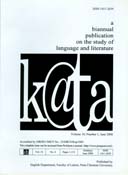King Lear: A Negatively Capable Outsider
Abstract
Negative capability, John Keats’s coined term, defines the ideal poet as being capable of being in uncertainties and mysteries without any irritable reaching after fact and reason. He insists that poets let the mind be a thoroughfare for all thoughts, by holding no fixed identity but metamorphic identities. Although Keats finds the ideal quality of a poet in Shakespeare the poet, it does not appear far from logical to investigate it in the characters of his plays, specifically king Lear, as he undergoes changes throughout the story and cuts across his enclosed self to enrich his receptivity to the actual vastness of life experience after he is estranged and labelled as an outsider in his erstwhile kingdom. In the present study I will employ the ongoing vigor of negative capability to take a step further ahead of its theoretically stipulated implications and investigate it on the character of king Lear.
Downloads
References
Bate, Walter Jackson. (1949). From Classic to Romantic: Premises of Taste in Eighteenth-Century England. Cambridge, Mass.: Harvard Univ. Press.
Benton, Richard. P. 2 (1966). Keats and Zen. Philosophy East and West, 16, 33-47.
Calderwood, James. L. (1986). Creative Uncreation in King Lear. Shakespeare Quarterly, 37(1), 5–19.
De Man, Paul. (1996). Aesthetic Ideology. Minneapolis: University of Minnesota Press.
Engell, James. (1981). The Creative Imagination: Enlightenment to Romanticism. Cambridge, Mass.: Harvard Univ. Press.
Foakes, R. A. (1994). Hamlet Versus Lear: Cultural Politics and Shakespeare’s Art. Cambridge: Cambridge University Press.
Han, Kwang-Sok. (2010). The Ontological Vision of Nothing and Realization of the True Self in King Lear.The Journal of East-West Comparative Literature, 22, 247–270.
Hazlitt, William and Hunt, Leigh. (1991). The Round Table: 1817. Oxford: Woodstock Books.
Keats, John. (2002). Selected Letters. Ed. Robert Gittings. Oxford World’s Classics. Oxford University Press.
---. (1899). The Complete Poetical Works and Letters of John Keats. Ed. Horace E. Scudder. Boston: Houghton Mifflin and Company.
Ou, Li. (2009). Keats and Negative Capability. London: Continum. eBook Super Collection- Austria. Web. 28 Feb. 2016.
Sandy, Mark. (2005). Poetics of Self and Form in Keats and Shelley: Nietzschean Subjectivity and Genre. Aldershot: Ashgate.
Schoff, Francis, G. (1962). King Lear: Moral Example or Tragic Protagonist. Shakespeare Quarterly, 13(2), 157–72.
Shakespeare, William. (2009). The Tragedy of King Lear. Ed. Barbara A. Mowat and Paul Werstine. New York: Simon & Schuster Paperbacks.
Whale, John. (2005). John Keats (Critical Issues). Basingstoke: Palgrave Macmillan.
White, R. S. (1987). Keats as a Reader of Shakespeare. London: The Athlone Press.

This work is licensed under a Creative Commons Attribution 4.0 International License.
![]() This work is licensed under a Creative Commons Attribution License
This work is licensed under a Creative Commons Attribution License




.png)
.png)

.png)












